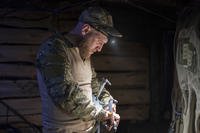The Israeli armored corps has long been revered as an elite force and Israel's first line of defense against hostile neighbors, which is why when IDF armor was roughly handled by Hezbollah in Lebanon in 2006 it sent shock waves through Israeli military and civilian realms. IDF armor has figured prominently in Israel’s ongoing ground campaign in Gaza against Hamas militants. It appears, so far anyway, that Hamas has been unable to repeat Hezbollah’s success and counter IDF tank incursions throughout Gaza.
I have yet to come across a report of an IDF tank hit by an anti-armor missile, although Israel is keeping a tight lid on press reports, as opposed to the fairly open feed during the 2006 Lebanon war, so it’s hard to say for certain (if any reader out there has found any reports of IDF tanks being hit please forward). The IDF’s blog said on Wednesday that seven Israeli paratroopers were wounded, one seriously, by Hamas anti-tank missile fire. The report did not say whether they were inside a vehicle.
Around 90 percent of IDF casualties in 2006 came from anti-armor missiles. Hezbollah had carefully prepared tank ambushes arrayed in depth and were armed with large numbers of AT-14 Kornet, TOW, Sagger and other anti-armor missiles that they used not just against tanks but as very effective, man-portable, precision artillery. A key to Hezbolla’s effectiveness was not just that they had advanced anti-armor missiles, but that they had lots and lots of missile reloads. This allowed Hezbollah fighters to be fairly prolific in their use, with salvo firing being a favored tactic; Merkava tanks took multiple missile hits.
Former IDF special forces soldier and occasional U.S. military consultant, Adam Harmon, told me the initial shock of the casualties in both men and tanks in the first days of the southern Lebanon ground offensive led to overcaution on the part of Israeli commanders in the following days. Harmon said many Israeli casualties resulted from soldiers clustering around armored vehicles, out in the open, presenting inviting targets to Hezbollah’s long range anti-armor missiles. Israeli tanks come equipped with an electronic warning system that tells the crew when they’ve been painted by a targeting laser, such as the Kornet uses. But as the missiles came in, IDF tank crews failed to fire off smoke screens that would have disrupted the lasers.
RAND’s Russell Glenn, who wrote an analysis last year of the Lebanon war, said it was those poor tactics on the part of the Israelis versus any specific Hezbollah weapons that led to the IDF’s being stymied in their ground attacks. Commanders failed to lead from the front and sent Israeli columns along predictable routes where they were ambushed by well prepared Hezbollah defenders.
It would appear that IDF tactical proficiency has improved in the intervening years. Glenn said after Lebanon, the IDF embarked on intensive combined arms training, specifically, calling in indirect fire and better coordination between air and ground forces. Hamas’ lack of success against Israeli armor might also be because they don’t have the anti-armor missile stockpile that Hezbollah had acquired or Hezbollah fighter’s training and discipline. In fact, reports from the fighting in Gaza indicate Hamas is not even in the same league as Hezbollah, which is a highly motivated and disciplined fighting force.
One thing is certain, when Israel rolls into places such as Gaza, it goes in heavy, very heavy. It leads with its Merkava tanks and APCs weighing close to 50 tons follow behind. Most of these vehicles were built to face Syrian armor on the Golan Heights. The IDF has found they're very effective in low intensity urban operations because of their armor protection and powerful sensors.
Seen in this IDF provided video clip of tank columns preparing to enter Gaza are a collection of Merkava 3 and the latest generation Merkava 4 main battle tank. I’ve had more than one American tank commander tell me the Merkava is superior to the M-1 Abrams in urban operations because they come with remotely controlled machine guns on the turret roof, a 60mm roof mounted mortar for use against infantry, an advanced laser warning system and a small crew compartment in the back.
Also visible are rows of the venerable, if somewhat vulnerable, M-113s fitted with Toga steel mesh screens to protect against shaped-charge warheads, and a collection of Achzarit heavy infantry assault carriers, which weigh in at 44 tons (the Bradley fighting vehicle weighs 30 tons). The Achzarit is a “Kangaroo” type carrier built on captured T-55 tank hulls with the turrets removed and additional spaced armor hung on the sides. Also visible are Puma combat engineer vehicles, another Kangaroo style modification built by removing the turret from British Centurion tanks to create a large fighting compartment.
Looking at IDF ground operations at the low intensity range, and the heavy armor they employ, I have to wonder why the U.S. Army is hell bent on building a new, and extremely expensive, family of medium-weight armored vehicles in the sub-30 ton range as the centerpiece of the service's FCS program. The simple fact is you cannot hang enough armor on a vehicle to protect against modern anti-armor weapons, and keep the weight that low. Russia, the other army with extensive urban combat experience against enemies with advanced anti-armor weapons, has also gone in for very heavy personnel carriers.
SecDef Gates has said that in future wars troops will face “hybrid enemies” of the type Israel faced in Hezbollah. By definition, that enemy will come equipped with a vast arsenal of heavy anti-armor weaponry. Pentagon planners would do well to adjust vehicle plans to account for hybrid enemies.








